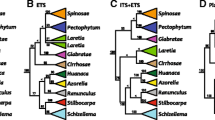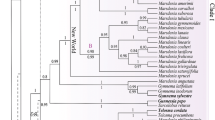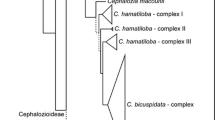Abstract
Two opposing opinions concerning the generic differentiation of Amaryllidaceae subtribe Strumariinae two taxonomic opinions were published in the last decade. According to Müller-Doblies and Müller-Doblies (1985, 1994) the Strumariinae includes eight genera, among themHessea, Namaquanula, andDewinterella. Snijman (1991) described the new genusKamiesbergia and acceptedNamaquanula (1992). Of the entire complex she recognized onlyHessea (Snijman 1994). The sectionMyophila was simultaneously described as the genusDewinterella by Müller-Doblies and Müller-Doblies.
The possible phylogenetic relationships of eight species belonging to these taxa are estimated from the sequences of the ITS regions of the 18S-25S rDNA. Two species ofNerine are used as the outgroup. The sequences of these taxa are analyzed with maximum parsimony, distance, and maximum likelihood methods. In all phylogenetic reconstructionsNamaquanula is confirmed to be an independant clade aside from all other six species of the Strumariinae. In this groupHessea andDewinterella turn out to be sister groups.Hessea stenosiphon (subgenusKamiesbergia) is the sister taxon ofH. breviflora.
Similar content being viewed by others
References
Baker J. G. (1888) Handbook of the Amaryllideae, including the Alstroemerieae and Agaveae. George Bell, London.
Baldwin B. G. (1992) Phylogenetic utility of the internal transcribed spacers of nuclear ribosomal DNA in plants: an example from the Compositae. Molec. Phylogenet. Evol. 1: 3–16.
Baldwin B. G. (1993) Molecular phylogenetics ofCalycadenia (Compositae) based on ITS sequences of nuclear ribosomal DNA: chromosomal and morphological evolution reexamined. Amer. J. Bot. 80: 222–238.
Barker W. F. (1948) Plantae novae africanae XX. J. S. African Bot. 14: 29–40.
Brummitt R. K. (1992) Vascular plant families and genera. Royal Botanic Gardens, Kew.
Dahlgren R. M. T., Clifford H. T., Yeo P. F. (1985) The families of the monocotyledones: structure, evolution, and taxonomy. Springer, Berlin Heidelberg New York Tokyo.
Dyer R. A. (1950) A review of the genusBrunsvigia. Pl. Life 6: 63–83.
Dyer R. A. (1951) A review of the genusBrunsvigia Heist. Pl. Life 7: 44–64.
Fay M. F., Chase M. W. (1996) Resurrection of Themidaceae for theBrodiaea alliance, and recircumscription of Alliaceae, Amaryllidaceae and Agapanthoideae. Taxon 45: 441–451.
Felsenstein J. (1993) PHYLIP (Phylogeny inference package), version 3.5c. Seattle.
Goldblatt P. (1976) Chromosome cytology ofHessea, Strumaria, andCarpolyza (Amaryllidaceae). Ann. Missouri Bot. Gard. 63: 314–320.
Greuter W., Brummitt R. K., Farr E., Kilian N., Kirk P. M., Silva P. C. (1993) Names in current use for extant plant genera. Koeltz Scientific Books, Königstein.
Gunn C. R., Wiersema J. H., Ritchie C. A., Kirkbride J. H. Jr. (1992) Families and genera of Spermatophytes recognized by the Agricultural Research Service. USDA, Beltsville, Maryland.
Herbert W. (1837) Amaryllidaceae. James Ridgway, London.
Higgins D. G., Bleasby A. J., Fuchs R. (1992) CLUSTAL V: improved software for multiple sequence alignment. Cabios 8: 189–191.
Hsiao C., Chatterton N. J., Asay K. H., Jensen K. B. (1994) Phylogenetic relationships of 10 grass species: an assessment of phylogenetic utility of the internal transcribed spacer region in nuclear ribosomal DNA in monocots. Genome 37: 112–120.
Hsiao C. (1995a) Molecular phylogeny of the Pooideae (Poaceae) based on nuclear rDNA (ITS) sequences. Theor. Appl. Genet. 90: 389–398.
Hsiao C. (1995b) Phylogenetic relationships of the monogenomic species of the wheat tribe, Triticeae (Poaceae), inferred from nuclear rDNA (internal transcribed spacer) sequences. Genome 38: 211–223.
Kimura M. (1980) A simple method for estimating evolutionary rate of base substitutions through comparative studies of nucleotide sequences. J. Molec. Evol. 16: 111–120.
Kumar S., Tamura K., Nei M. (1993) MEGA: Molecular evolutionary genetics analysis, version 1.01. Pennsylvania.
Kunth C. S. (1850) Enumeratio plantarum omnium hucusque cognitarum, secundum familias naturales disposita, adjectis characteribus, differentiis et synonymis 5: Enumeratio Asparaginearum. J. C. Collae, Stuttgart, Tübingen.
Leighton F. M. (1948) Some changes in nomenclature: V. J. S. African Bot. 14: 81–83.
Maddison W. P., Maddison D. R. (1992) Mac-Clade: Interactive analysis of phylogeny and character evolution. Sunderland.
Milne-Redhead E., Schweickerdt H. G. (1939) A new conception of the genusAmmocharis Herb. J. Linn. Soc., Bot. 52: 159–197.
Müller-Doblies D., Müller-Doblies U. (1985) De Liliifloris notulae: 2. De taxonomia subtribus Strumariinae (Amaryllidaceae). Bot. Jahrb. Syst. 107: 17–47.
Müller-Doblies D., Müller-Doblies U. (1992) De Liliifloris notulae: 4. Notes onHessea (includingKamiesbergia; Amaryllidaceae of southern Africa). Gleditschia 20: 15–20.
Müller-Doblies D., Müller-Doblies U. (1994) De Liliifloris notulae: 5. Some new taxa and combinations in the Amaryllidaceae tribe Amaryllideae from arid southern Africa. Feddes Repert. 105: 331–363.
Nordal I. (1977) Revision of the East African taxa of the genusCrinum (Amaryllidaceae). Norweg. J. Bot. 24: 179–194.
Nordal I., Wahlstrøm R. (1980) A study of the genusCrinum (Amaryllidaceae) in Cameroun. Adansonia, ser. 2 20: 179–198.
Obermeyer A. A. (1963)Hessea tenella. Fl. Pl. Africa 36 (“1964”): t. 1413.
Saitou N., Nei M. (1987) The neighbor-joining method: a new method for reconstructing phylogenetic trees. Molec. Biol. Evol. 4: 406–425.
Salisbury R. A (1866) The genera of plants: a fragment containing part of Liriogamae. John van Voorst, London.
Sambrook J., Fritsch E. F., Maniatis T. (1989) Molecular cloning, Cold Spring Harbor Laboratory, New York.
Shinwary K. Z., Terauchi R., Utech F. H., Kawano S. (1994) Recognition of the New WorldDisporum sectionProsartes asProsartes (Liliaceae) based on the sequence data of therbcL gene. Taxon 43: 353–366.
Snijman D. A. (1991)Kamiesbergia, a new monotypic genus of the Amaryllideae — Strumariinae (Amaryllidaceae) from the north-western Cape. Bothalia 21: 125–128.
Snijman D. A. (1992) Review of the systematics of the Strumariinae (Amaryllidaceae). Herbertia 48: 52–57.
Snijman D. A. (1994) Systematics ofHessea, Strumaria andCarpolyza (Amaryllideae: Amaryllidaceae). Cape Town, Bolus Herbarium.
Snijman D. A., Perry P. (1987) A floristic analysis of the Nieuwoudtville Wild Flower Reserve, north-western Cape. S. African J. Bot. 53: 445–454.
Swofford D. L. (1993) PAUP: phylogenetic analysis using parsimony, version 3.1.1. Champaign.
Tajima F., Nei M. (1984) Estimation of evolutionary distance between nucleotide sequences. Molec. Biol. Evol. 1: 269–285.
Traub H. P. (1957) Classification of the Amaryllidaceae: subfamilies, tribes and genera. Pl. Life 13: 76–83.
Traub H. P. (1963) The genera of Amaryllidaceae. The American Plant Life Society, La Jolla, Calif.
Traub H. P. (1967) Review of the genusNerine. Pl. Life 23: 1–32 (Suppl.).
Verdoorn I. C. (1973) The genusCrinum in southern Africa. Bothalia 11: 27–52.
Wojciechowski M. F., Sanderson M. J., Baldwin B. G., Donoghue M. J. (1993) Monophyly of aneuploidAstragalus (Fabaceae): evidence from nuclear ribosomal DNA internal transcribed spacer sequences. Amer. J. Bot. 80: 711–722.
Author information
Authors and Affiliations
Rights and permissions
About this article
Cite this article
Weichhardt-Kulessa, K., Börner, T., Schmitz, J. et al. Controversial taxonomy of Strumariinae (Amaryllidaceae) investigated by nuclear rDNA (ITS) sequences. Pl Syst Evol 223, 1–13 (2000). https://doi.org/10.1007/BF00985323
Received:
Accepted:
Issue Date:
DOI: https://doi.org/10.1007/BF00985323




